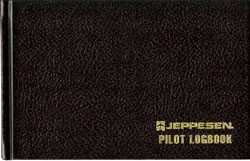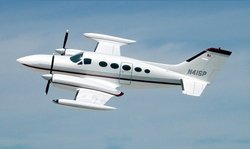Wiblin Wonders If Auto-Pilot Time Should Count
by Gary Wiblin, Editor, International Aviation & Safety
Forum
 I recently spent some time having
lunch with an airline pilot friend of mine and the topic of flying
hours logged came up. It was during our conversation that I began
to question the system of logging flight hours we are subject
to.
I recently spent some time having
lunch with an airline pilot friend of mine and the topic of flying
hours logged came up. It was during our conversation that I began
to question the system of logging flight hours we are subject
to.
This particular pilot flies international routes between South
Africa and the USA and regularly logs in excess of 10 hours for
each crossing. I asked if he, the Captain, actually sat in the
pilots seat for the entire trip and he said that for at least half
those hours he was either sitting elsewhere reading or in a bunk,
sleeping. Even then, when he was sitting in the pilots seat, the
huge aircraft was being guided along pre-determined pathways by a
pre-programmed computer system and was also being carefully
monitored by countless personnel on the ground. This got me
thinking.
There is obviously a vast difference between an airline Captain
and a charter pilot. I do acknowledge that many airline pilots
began their flying careers as charter pilots but many of them
stepped but briefly into that realm before spending the rest of
their working lives in the sharp end of a large airliner. It is
therefore obvious that the hours logged by an international airline
pilot have a somewhat different texture to those logged by a
charter pilot.
It would appear that a charter pilot faces a somewhat different
working day to that of an international airline pilot. A charter
pilot notoriously needs to be airborne at 6am and therefore has
access to no reliable meteorological information when doing his
flight planning at 4am. He often needs to collect the catering on
route to the airport. He then needs to be at the airport at 5am to
remove the aircraft from its hangar and prepare it for flight. When
the passengers arrive he needs to "check them in" and issue them
with tickets.
He needs to offer coffee and pack their bags into the aircraft.
The passengers need to be boarded and the pilot must give a safety
briefing. It is almost certain that one of the passengers will be
sitting up front with the pilot and during the entire flight will
ply the pilot with an endless stream of questions that need to be
answered politely and accurately. At destination, the pilot may
well need to sit at a deserted airfield and wait while his
passengers go into town to conduct their business. The passengers
will arrive back at the aircraft later than they said they
would.
 With the weather worsening and
visibility for take-off looking marginal, the pilot will have no
access to RVR (runway visual range) information or have any idea
what the weather is like after take off. He will need to make an
educated guess as to whether it is safe to go. A decision to stay
the night due to worsening weather is always met with derision and
scorn and your ability as a pilot will be in question. On the way
home the passengers will partake of the liquid refreshments in the
cooler box and will often become rowdy and boisterous. About an
hour into the flight they will question how much longer before
landing, as the downed beers will need to be expunged, one way or
another. On hearing that they will still need to wait another hour
the cabin will take on an eerie quietness. After the landing the
passengers will remember only the uncomfortable section of the
flight, when they were longing for a toilet, and will leave with
but a cursory wave. After tidying the aircraft and returning it to
its hangar, you will arrive home after a 16-hour day consisting of
hard labor, boredom, fright, and derision, and will get to log four
hours in your logbook.
With the weather worsening and
visibility for take-off looking marginal, the pilot will have no
access to RVR (runway visual range) information or have any idea
what the weather is like after take off. He will need to make an
educated guess as to whether it is safe to go. A decision to stay
the night due to worsening weather is always met with derision and
scorn and your ability as a pilot will be in question. On the way
home the passengers will partake of the liquid refreshments in the
cooler box and will often become rowdy and boisterous. About an
hour into the flight they will question how much longer before
landing, as the downed beers will need to be expunged, one way or
another. On hearing that they will still need to wait another hour
the cabin will take on an eerie quietness. After the landing the
passengers will remember only the uncomfortable section of the
flight, when they were longing for a toilet, and will leave with
but a cursory wave. After tidying the aircraft and returning it to
its hangar, you will arrive home after a 16-hour day consisting of
hard labor, boredom, fright, and derision, and will get to log four
hours in your logbook.
An international airline pilot, on the other hand, will arrive
at work to find that all flight planning has been well taken care
of and the aircraft has been fully prepared for take-off.
Passengers will be checked in and boarded and the Captain will
merely apply a standard set of rules pertaining to the take-off or
in deciding on any alternative routing due weather. There will be
no surprises and a veritable team of experts will take care every
detail right down to strapping passengers in and giving them a
safety briefing. After take-off the Captain will activate the bevy
of computers tasked with flying the big bird and will settle back
with a nice hot cuppa! It is therefore quite obvious that the
international airline captain with 10 000 hours may well have less
claim to 10 000 hours of flying experience than the charter pilot
with a similar number of hours logged.
I also once knew a pilot who logged all his hours on an IF
flight plan as actual instrument flying. When I advised that he
could only log instrument flight time when he was manipulating the
controls with no outside reference to the horizon he appeared
unconvinced. To the best of my knowledge this pilot continues to
log all his flying as instrument flight merely because he has filed
an IFR flight plan.

The point of all this is to perhaps call for a shake-up of the
way flight time is logged. To my mind, in order to log flight time
as a pilot, you should at the very least be sitting in the pilots
seat, as well as being the pilot in command. In order to log
instrument flight time, you should be manually flying the aircraft
with absolutely no reference to the horizon.
A logbook should be an accurate record of your flying
experience, and not just time spent in an aircraft, or a wish list.
I personally keep an extremely accurate log of all my flying
experience and often enjoy paging through my logbooks, knowing that
each and every minute recorded was a real moment in time flying an
aircraft.
(Gary Wiblin is editor of the online South African journal
"International Aviation Safety Forum." He's also out with a new
print publication -- "Aviation and Safety Magazine." Visit his
website for information on how to subscribe. --
ed.)
 ANN's Daily Aero-Term (04.25.24): Airport Rotating Beacon
ANN's Daily Aero-Term (04.25.24): Airport Rotating Beacon ANN's Daily Aero-Linx (04.25.24)
ANN's Daily Aero-Linx (04.25.24) Klyde Morris (04.22.24)
Klyde Morris (04.22.24) Airborne 04.24.24: INTEGRAL E, Elixir USA, M700 RVSM
Airborne 04.24.24: INTEGRAL E, Elixir USA, M700 RVSM Airborne 04.22.24: Rotor X Worsens, Airport Fees 4 FNB?, USMC Drone Pilot
Airborne 04.22.24: Rotor X Worsens, Airport Fees 4 FNB?, USMC Drone Pilot





